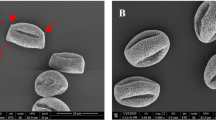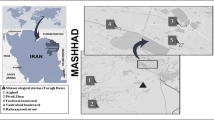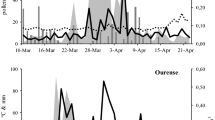Abstract
As one of biological particles, pollen grains could be suspended in air and cause health risks such as pollinosis and rhinitis. Air pollutants can be absorbed on the pollen grains which would increase allergenicity. However, few studies have been focused on characterization of polycyclic aromatic hydrocarbons (PAHs), one kind of toxic pollutants absorbed on pollen grains, and their relationships with the allergenic proteins. In this study, fresh Platanus pollen samples were collected in the central parking area and the outer ring area of Shanghai in the spring of 2023. Mass concentration of allergenic protein (Pla a3) released from the samples collected at the two sampling sites were investigated by using western blot assay and enzyme linked immunosorbent assay, while mass levels of PAHs absorbed on the surface of flower inflorescence and pollen grains were measured by using GC-MS. Our data showed that the mass level of Pla a3 released from the pollen grains collected in the parking area was significantly higher than that collected in the outer ring area. Mass level of PAHs on the flower inflorescence and pollen grains in the parking area was 2 times higher than that in the outer ring area. The molecular docking results indicated that four disulfide bonds (Cys4-Cys52, Cys14-Cys29, Cys30-Cys75, Cys50-Cys89) in the Pla a3 protein structure could interact with the PAHs by hydrogen bonds. This interaction could increase the structural stability of the protein and enhance the allergenicity.




Similar content being viewed by others
References
Dallakyan, S., & Olson, A. J. (2015). Small-molecule library screening by docking with PyRx. Methods in Molecular Biology, 1263, 243–250.
Feng, M., Lu, S., Zhang, R., Shen, C., Huang, J., Wang, Y., Wu, L., Feng, J., & Wu, M. (2011). Preliminary studies on complex pollution caused by ambient allergenic pollens and urban particulate matters in Shanghai. China Environmental Science, 31(7), 1095–1101.
Ghiani, A., Aina, R., Asero, R., Bellotto, E., & Citterio, S. (2012). Ragweed pollen collected along high-traffic roads shows a higher aller-genicity than pollen sampled in vegetated areas. Allergy, 67, 887–894.
Grewling, Ł, Bogawski, P., Kostecki, Ł, Nowak, M., Szymańska, A., & Frątczak, A. (2020). Atmospheric exposure to the major Ar-temisia pollen allergen (Art v 1): Seasonality, impact of weather, and clinical implications. Science of the Total Enviroment. https://doi.org/10.1016/j.scitotenv.2020.136611
Grundström, M., Dahl, Å., Ou, T., Chen, D., & Pleijel, H. (2017). The relationship between birch pollen, air pollution and weather types and their effect on antihistamine purchase in two Swedish cities. Aerobiologia (Bologna), 33, 457–471.
Harrison, R., & Pant, P. (2013). Estimation of the contribution of road traffic emissions to particulate matter concentrations from field measurements: A review. Atmospheric Environment, 77, 78–97.
Hong, Q., Zhou, S., Zhao, H., Peng, J., Li, Y., Shang, Y., Wu, M., Zhang, W., Lu, S., Li, S., Yu, S., Wang, W., & Wang, Q. (2018). Allergenicity of recombinant Humulus japonicus pollen allergen 1 after combined exposure to ozone and nitrogen dioxide. Environmental Pollution, 234, 707–715.
Huffman, J. A., Treutlein, B., & P¨oschl, U. (2010). Fluorescent biological aerosol particle concentrations and size distributions measured with an ultraviolet aerodynamic particle sizer (UV-APS) in central Europe. Atmospheric Chemistry and Physics, 10, 3215–3233. https://doi.org/10.5194/acp-10-3215-2010
Lambert, O., Veyrand, B., Durand, S., Marchand, P., Bizec, B., Piroux, M., Puyo, S., Thorin, C., Delbac, F., & Pouliquen, H. (2012). Polycyclic aromatic hydrocarbons: Bees, honey and pollen as sentinels for environmental chemical contaminant. Chemosphere, 86, 98–104.
Lin, Y., Enyoh, C. E., Wang, Q., Lu, S., Zhang, W., Xiao, K., Zhou, S., Kaneko, T., Seguchi, A., Wang, W., & Guo, Y. (2022). Novel approaches for inhibiting the indoor allergen Der f 2 excreted from house dust mites by todomatsu oil produced from woodland residues. International Journal of Environmental Research and Public Health, 19(17), 10881. https://doi.org/10.3390/ijerph191710881
Liu, Y., Yan, C., Ding, X., Wang, X., Fu, Q., Zhao, Q., Zhang, Y., Duan, Y., Qiu, X., & Zheng, M. (2017). Sources and spatial distribution of particulate polycyclic aromatic hydrocarbons in Shanghai, China. Science of the Total Environment, 584–585, 307–317.
Lu, S., Win, M., Zeng, J., Yao, C., Zhao, M., Xiu, G., Lin, Y., Dai, Y., Rao, L., Zhang, L., Yonemochi, S., & Wang, Q. (2019). A characterization of HULIS-C and the oxidative potential of HULIS and HULIS-Fe(II) mixture in PM2.5 during hazy and non-hazy days in Shanghai. Atmospheric Environment, 219, 117058.
Misiukiewicz-Stepien, P., & Paplinska-Goryca, M. (2021). Biological effect of PM10 on airway epithelium-focus on obstructive lung diseases. Clinical Immunology, 227, 108754.
Peden, D., & Reed, C. E. (2010). Environmental and occupational allergies. The Journal of Allergy and Clinical Immunology, 125, 150–160.
Plaza, M., Alcazar, P., Hernandez-Ceballos, M., & Galan, C. (2016). Mismatch in aeroallergens and airborne grass pollen concentrations. Atmospheric Environment, 144, 361–369.
Sedghy, F., Sankian, M., Moghadam, M., Ghasemi, Z., Mahmoudi, M., & Varasteh, A. R. (2017). Impact of traffic-related air pollution on the expression of Platanus orientalis pollen allergens. International Journal of Biometeorology, 61, 1–9.
Smiljanic, K., Prodic, I., Apostolovic, D., Cvetkovic, A., Veljovic, D., Mutic, J., Hage, M., Burazer, L., & Velickovic, T. (2019). In-depth quantitative profiling of post-translational modifications of Timothy grass pollen allergome in relation to environmental oxidative stress. Environment International, 126, 644–658.
Ugale, C., & Tidke, J. A. (2022). Air pollution effects on Datura innoxia mill. pollen structure, protein and germination. Aerobiologia, 38(3), 379–390.
Wang, X., Miao, Y., Zhang, Y., Li, Y., Wu, M., & Yu, G. (2012). Polycyclic aromatic hydrocarbons (PAHs) in urban soils of the megacity Shanghai: Occurrence, source apportionment and potential human health risk. Science of the Total Environment, 447, 80–89.
Yue, W., Chen, F., Xue, X., Cao, W., & Wu, L. (2016). Rapid determination of polycyclic aromatic hydrocarbons in bee pollen by GC-MS coupled with modified Qu ECh ERS. Journal of Chinese Institute of Food Science and Technology, 8, 2011–2017.
Zhou, S., Wang, X., Lu, S., Yao, C., Zhang, L., Rao, L., Liu, X., Zhang, W., Li, S., Wang, W., & Wang, Q. (2021). Characterization of allergenicity of Platanus pollen allergen a 3 (Pla a3) after ex-posure to NO2 and O3. Environmental Pollution, 278, 116913.
Zhou, S., Zhao, H., Peng, J., Hong, Q., Xiao, K., Shang, Y., Lu, S., Zhang, W., Wu, M., Li, S., Yu, S., & Wang, Q. (2019). Size distribution of Platanus acerifolia allergen 3 (Pla a3) in Shanghai ambient size-resolved particles and its allergenic effects. Atmospheric Environment, 198(1), 324–334.
Acknowledgements
This research was funded by the Science and Technology Committee of Shanghai (21DZ1202300)
Funding
This study was supported by the Science and Technology Committee of Shanghai (21DZ1202300).
Author information
Authors and Affiliations
Contributions
LS designed the study, instructed all experiments. ZL drafted the manuscript. LJ and ZS were responsible for the experiments. LX analyzed the data of PAHs. ZW and SY provided instruction on chemical analysis. LY, ECE checked grammars and revised the manuscript. WW, WQ revised the manuscript.
Corresponding author
Ethics declarations
Conflict of interest
The authors declare the following financial interests/personal relationships which may be considered as potential competing interests: The authors declare that they have no known competing financial interests or personal relationships that could have appeared to influence the work reported in this paper. On behalf of the all authors, Senlin Lu.
Supplementary Information
Below is the link to the electronic supplementary material.
Rights and permissions
Springer Nature or its licensor (e.g. a society or other partner) holds exclusive rights to this article under a publishing agreement with the author(s) or other rightsholder(s); author self-archiving of the accepted manuscript version of this article is solely governed by the terms of such publishing agreement and applicable law.
About this article
Cite this article
Senlin, L., Lu, Z., Jin, L. et al. Expression of allergenic protein and polycyclic aromatic hydrocarbons in the Platanus pollen grains collected from different area of Shanghai. Aerobiologia (2024). https://doi.org/10.1007/s10453-023-09805-7
Received:
Accepted:
Published:
DOI: https://doi.org/10.1007/s10453-023-09805-7




